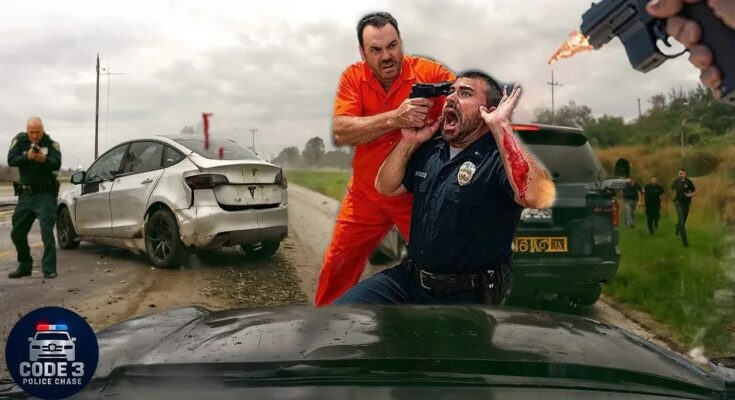One second can change everything. A police chase that began with screeching tires has spiraled into a life-or-death standoff on a desolate road. A desperate prisoner, fresh out of a wrecked car, clings to survival by holding an officer hostage. Gunfire erupts, backup rushes in, and every breath counts. This isn’t just a chase—it’s the thin line between chaos and control, between law and lawlessness.
The image captures a moment that feels like the climax of an action thriller, yet it reflects deeper realities about crime, law enforcement, and the razor-thin margin separating order from disorder. At first glance, we see a chaotic roadside scene: a damaged car, armed officers, and a desperate man in an orange prison jumpsuit forcing a police officer into submission with a gun to his head. What unfolds here is more than just violence—it’s a snapshot of human desperation, authority, and the fragile balance of justice.
The man in orange represents rebellion and defiance. His jumpsuit identifies him as a prisoner or convict, someone who has already been through the justice system. His actions, however, reveal a refusal to accept accountability or fate. Instead of surrendering to the inevitable, he takes the most extreme measure possible—using a law enforcement officer as a shield, bargaining chip, and symbol of resistance. It is the ultimate expression of desperation: when an individual feels so cornered by circumstances that the only perceived way out is through escalating violence.
On the other hand, the police presence symbolizes structure and order. Law enforcement officers in this scene are not only trying to save their colleague but also striving to prevent chaos from spilling into the wider public. Their weapons are drawn, their bodies tense with adrenaline, each of them calculating how to neutralize the threat without endangering the hostage. This moment illustrates the immense pressure police officers face in real time—where decisions are made in seconds and lives hang in the balance.
The wrecked car in the background tells its own story. It is the silent witness to the chase that led here, the reason adrenaline is surging through every participant in this tableau. It represents speed, escape, and failure. The damaged metal, shattered windows, and dirt kicked up on the roadside all point to the chaos that unfolded just moments before the standoff. In essence, the car serves as the bridge between the initial attempt at freedom and the harsh reality of being cornered.
The hostage police officer in the center of the image is perhaps the most human element of all. His face twisted in pain and fear, his arms raised in helplessness, he embodies vulnerability. Despite his badge, uniform, and authority, in this instant he is stripped of power. His role flips—from protector of the public to victim of violence. This reversal reminds us that law enforcement officers, though symbols of strength and safety, are also human beings susceptible to suffering, pain, and mortality.
Psychologically, the standoff highlights the thin boundary between control and collapse. The prisoner seeks control through force, yet it is ultimately an illusion. Surrounded by armed officers, he knows that his situation is unsustainable. At best, he may delay the inevitable. At worst, he may provoke a tragic end. Meanwhile, the officers face their own struggle with control. They must suppress natural fear and emotion, relying on training, communication, and trust to bring the situation under control without further bloodshed.
Symbolically, this scene represents the clash between chaos and order. The orange jumpsuit—a universal marker of imprisonment—stands out against the darker uniforms of the officers. The fiery flash of a gunshot contrasts with the stormy gray sky, emphasizing the violence disrupting an otherwise quiet rural setting. This visual symbolism underscores the fragility of peace: how quickly it can be shattered, and how difficult it is to restore once broken.
In a broader sense, the image reflects society’s struggle with crime and justice. Every chase, every arrest, every trial is a battle between accountability and rebellion, between the collective safety of the public and the individual defiance of those who resist it. While the standoff may appear as an isolated event, it mirrors a universal theme: the constant effort required to uphold order in a world where desperation, fear, and violence are never far away.
Ultimately, this moment frozen in time reminds us of the cost of choices. The prisoner’s choice to resist escalated his fate. The officer’s choice to serve placed him in harm’s way. And the responding team’s choices in the next few seconds will determine whether this story ends in tragedy or survival.



